 |
 |
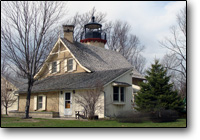 |
| Click thumbnails to view enlarged images 84°46'22.86"W | ||
| McGulpin Point Lighthouse | Seeing The Light |
|
|
|
|
Historical Information The
promontory which would become known as McGulpin Point has a history
which starts perhaps thousands of years ago with Native American use
and continues into the 20th Century as a lighthouse location. According
to the oral traditions of the Anishnaabek, Native Americans arrived and
settled in the Straits of Mackinac many generations before the arrival
of the first Europeans. Anishnaabek history tells of the Odawa coming
to the Straits of Mackinac to expel an earlier tribe living in Northern
Michigan. According to Odawa historian Andrew J. Blackbird, this tribe
was called the Mus-co-desh. In Blackbird’s story, a great insult was
delivered to the Odawa by the Mus-co-desh, who then occupied what is
now Emmet County. This insult so infuriated the great war chief Sagemaw
that he immediately went back to his villages on Manitoulin Island to
gather a war party to right this wrong. The result was the near
extermination of the Mus-co-desh and their expulsion from Northern
Michigan. The Odawa took advantage of this vacuum and moved into Emmet
County, first settling at McGulpin Point.
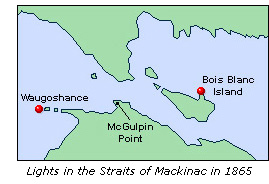 American
written history tells us that John McAlpine and his Native American
wife lived on McGulpin Point in the 1760s. After the turbulence of the
Revolutionary War the land was surveyed for the new United States of
America by Aaron Greeley and ownership was determined. John McAlpine’s
son and heir, Patrick McGulpin, was given the patent on this land and
holds the first recorded deed in Emmet County, Michigan in 1811. American
written history tells us that John McAlpine and his Native American
wife lived on McGulpin Point in the 1760s. After the turbulence of the
Revolutionary War the land was surveyed for the new United States of
America by Aaron Greeley and ownership was determined. John McAlpine’s
son and heir, Patrick McGulpin, was given the patent on this land and
holds the first recorded deed in Emmet County, Michigan in 1811.With the opening of the Erie Canal in 1825, Americans started to flood to the Chicago area. During the 1850s, vessel traffic through the Straits of Mackinac was increasing rapidly, and while the Waugoshance Light marked the western entry into the Straits, and the Bois Blanc Island light marked the eastern entry, the absence of a navigational aid within the shoal-ridden Straits themselves made passage during darkness and periods of low visibility extremely dangerous. To answer that need, the Lighthouse Board petitioned Congress for the construction of a lighthouse and fog bell at McGulpin Point, approximately two miles west of Fort Michilimackinac. Congress responded favorably to the request on August 3, 1854 with the appropriation of $6,000 for the station’s construction. 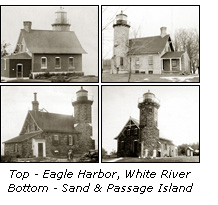 However,
as a result of difficulties in obtaining clear title to the land, no
action was taken on the station’s construction for more than a decade.
With the original appropriation unspent and expired, the Board again
petitioned Congress for the construction of a station at McGulpin Point
in 1864, this time receiving $20,000 for the project on July 26, 1866. However,
as a result of difficulties in obtaining clear title to the land, no
action was taken on the station’s construction for more than a decade.
With the original appropriation unspent and expired, the Board again
petitioned Congress for the construction of a station at McGulpin Point
in 1864, this time receiving $20,000 for the project on July 26, 1866.Work began at McGulpin Point early in 1869, and the station was built as a mirror image of the design used at Chambers Island and Eagle Bluff lights under construction in the Door County area that same year. This plan, which is sometimes referred to as the “Norman Gothic” style, was also later also used at Eagle Harbor in 1871, White River in 1875, and at Passage and Sand Islands in 1882. The keepers dwelling and integrated tower were constructed of Cream City brick with the tower integrated diagonally into the northwest corner of the dwelling. The first and second stories of the tower were approximately ten feet square with buttressed corners, while the tower’s upper portion consisted of a ten-foot octagon. Similar to other stations built on this plan, the tower is double-walled with a circular inner wall approximately four inches thick and eight feet in diameter to house a set of cast iron spiral stairs. The tower was capped with a prefabricated decagonal cast-iron lantern and outfitted with a fixed white Third-and-a-half Order Fresnel lens.  The
building sat on a full basement, which contained two general-purpose
areas and an oil storage room. For transport of supplies into the
tower, the cast iron spiral stairs connected the oil room to the tower,
and they served as the only stairs between the living areas with
landings and doors on the first and second floors. The first floor
contained a parlor, kitchen and two bedrooms, and the second floor
featured two additional bedrooms and a large closet. Almost as an
afterthought, a combined wood shed & summer kitchen was built
in
the form of an addition to the rear of the building. The
building sat on a full basement, which contained two general-purpose
areas and an oil storage room. For transport of supplies into the
tower, the cast iron spiral stairs connected the oil room to the tower,
and they served as the only stairs between the living areas with
landings and doors on the first and second floors. The first floor
contained a parlor, kitchen and two bedrooms, and the second floor
featured two additional bedrooms and a large closet. Almost as an
afterthought, a combined wood shed & summer kitchen was built
in
the form of an addition to the rear of the building.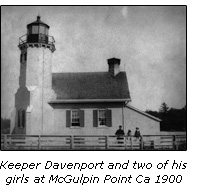 Among
the Station’s most notable keepers was James Davenport, who after
serving at Waugoshance and Little Point Sable, was transferred to
McGulpin Point in September of 1879. He held this position twenty-seven
years, until the station was discontinued in 1906. The Davenport family
lived the entire navigation season in the lighthouse. After the close
of the navigation season every year, they moved into to their home in
Mackinaw City so that the children could get to and from school, the
snow making the trip from town to the lighthouse virtually impossible. Among
the Station’s most notable keepers was James Davenport, who after
serving at Waugoshance and Little Point Sable, was transferred to
McGulpin Point in September of 1879. He held this position twenty-seven
years, until the station was discontinued in 1906. The Davenport family
lived the entire navigation season in the lighthouse. After the close
of the navigation season every year, they moved into to their home in
Mackinaw City so that the children could get to and from school, the
snow making the trip from town to the lighthouse virtually impossible.Correspondence files in the National Archives in Washington show that Davenport made weekly trips through the snow to the lighthouse to report on its condition to the District Inspector in Milwaukee. Perhaps more importantly, these letters also show that he may have played a critical role in the opening of navigation every spring by reporting weekly, and sometimes even more frequently, on ice conditions in the Straits. Awareness of "ice-out" in the Straits was critical to mariners, since the melting of the ice opened navigation to the critical ports of Chicago and Milwaukee. 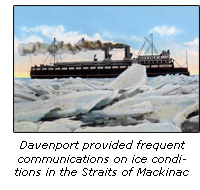 Because
Davenport was the only Straits keeper to submit such frequent reports,
it would appear that the Inspector used these reports to gain an
understanding as to when navigation would be open throughout the lakes.
Most of Davenport’s weekly winter reports consisted of terse commentary
as exemplified by his letter of March 28, 1890 in which he reported
“Sir, Ice in the Straits between here and Mackinac Island is broke up
some so that it moved a little with the heavy E. wind last night. But
no water to be seen west of this station as far as can be seen with a
glass. The ice is good and solid. Teams crossed the Straits yesterday.
Lake Huron is clear of ice up to Mackinac Island. This station is in
good order.” Davenport was absolutely meticulous in filing these
reports on a weekly basis with the exception of a single week in 1891,
when he missed filing his report. His sad letter of March 23rd of that
same year provided the reason for his missing the report, when he wrote
“Sir, I just was up in the Lt House and found all in good order. You
will see by this report that I did not report to you last week. My wife
and child died last week and I could not go up to the light house to
report to you as required.” Because
Davenport was the only Straits keeper to submit such frequent reports,
it would appear that the Inspector used these reports to gain an
understanding as to when navigation would be open throughout the lakes.
Most of Davenport’s weekly winter reports consisted of terse commentary
as exemplified by his letter of March 28, 1890 in which he reported
“Sir, Ice in the Straits between here and Mackinac Island is broke up
some so that it moved a little with the heavy E. wind last night. But
no water to be seen west of this station as far as can be seen with a
glass. The ice is good and solid. Teams crossed the Straits yesterday.
Lake Huron is clear of ice up to Mackinac Island. This station is in
good order.” Davenport was absolutely meticulous in filing these
reports on a weekly basis with the exception of a single week in 1891,
when he missed filing his report. His sad letter of March 23rd of that
same year provided the reason for his missing the report, when he wrote
“Sir, I just was up in the Lt House and found all in good order. You
will see by this report that I did not report to you last week. My wife
and child died last week and I could not go up to the light house to
report to you as required.”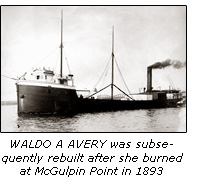 December
5, 1893 was a particularly eventful one at McGulpin Point when the
wooden propeller WALDO A. AVERY caught fire while passing through the
Straits. By the time the vessel was off McGulpin Point, the fire was
raging so badly that in order to save his crew, the captain steered the
vessel toward the lighthouse at full steam. Keeper Davenport had left
the station for Mackinaw City earlier in the day, and with the
aforementioned passing of his wife two years prior, had left his nine
children alone at the station. Accustomed to lighthouse life, the
children were a resourceful group, and made preparations for the care
of the survivors. Imagine the fear in the children’s hearts as they saw
the crew members literally fighting for their lives on the approaching
vessel. Alerted to what was going on at the lighthouse, Davenport
rushed back to the station with a number of Mackinaw City residents.
With the vessel’s lifeboat burned and unusable, numerous trips to the
burning and beached vessel were made with the Station’s small skiff,
until all seventeen crew members had been brought to safety on the
shore. The AVERY’s insurance for the season had expired the previous
day, and while the vessel was declared a complete loss at the time, the
hull was recovered in 1894. The vessel was rebuilt, and continued to
ply the lakes until she was finally abandoned in 1923. December
5, 1893 was a particularly eventful one at McGulpin Point when the
wooden propeller WALDO A. AVERY caught fire while passing through the
Straits. By the time the vessel was off McGulpin Point, the fire was
raging so badly that in order to save his crew, the captain steered the
vessel toward the lighthouse at full steam. Keeper Davenport had left
the station for Mackinaw City earlier in the day, and with the
aforementioned passing of his wife two years prior, had left his nine
children alone at the station. Accustomed to lighthouse life, the
children were a resourceful group, and made preparations for the care
of the survivors. Imagine the fear in the children’s hearts as they saw
the crew members literally fighting for their lives on the approaching
vessel. Alerted to what was going on at the lighthouse, Davenport
rushed back to the station with a number of Mackinaw City residents.
With the vessel’s lifeboat burned and unusable, numerous trips to the
burning and beached vessel were made with the Station’s small skiff,
until all seventeen crew members had been brought to safety on the
shore. The AVERY’s insurance for the season had expired the previous
day, and while the vessel was declared a complete loss at the time, the
hull was recovered in 1894. The vessel was rebuilt, and continued to
ply the lakes until she was finally abandoned in 1923.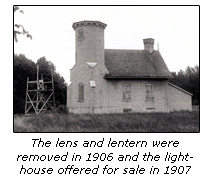 With
the construction of the Old Mackinac Point light and fog signal station
in 1892, the Lighthouse Board decided that McGulpin point station no
longer served its once critical role, since the new light at Old
Mackinac Point was visible from throughout the Straits, whereas
McGulpin Point was only effectively visible from the west. The
Lighthouse Board officially authorized the discontinuance of McGulpin
point on November 12, 1906, and keeper Davenport climbed the stairs to
exhibit his light for the last time on the closing of the navigation
season on December 15 of that year. With
the construction of the Old Mackinac Point light and fog signal station
in 1892, the Lighthouse Board decided that McGulpin point station no
longer served its once critical role, since the new light at Old
Mackinac Point was visible from throughout the Straits, whereas
McGulpin Point was only effectively visible from the west. The
Lighthouse Board officially authorized the discontinuance of McGulpin
point on November 12, 1906, and keeper Davenport climbed the stairs to
exhibit his light for the last time on the closing of the navigation
season on December 15 of that year. 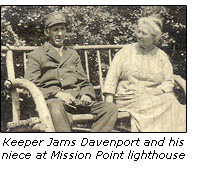 The station
was
boarded-up and the
lantern and lens removed, with Davenport serving as caretaker for a few
weeks until his transfer to Mission Point lighthouse where he continued
to serve until his retirement in 1917. On retirement, he returned to
Mackinaw City, where he lived-out the remainder of his life, passing
away on March 18, 1932 at the age of eighty-five. The station
was
boarded-up and the
lantern and lens removed, with Davenport serving as caretaker for a few
weeks until his transfer to Mission Point lighthouse where he continued
to serve until his retirement in 1917. On retirement, he returned to
Mackinaw City, where he lived-out the remainder of his life, passing
away on March 18, 1932 at the age of eighty-five.While records show that McGulpin Point’s lens was temporarily stored at Old Mackinac Point lighthouse, the eventual disposition of both the station’s lens and lantern remain undetermined. Approval was issued by the Board to sell the lighthouse at auction on May 22, 1907, and advertisements of the sale were published in the Cheboygan, Chicago, Detroit and Milwaukee newspapers with sealed bids received to be opened on July 17. The highest bid received was only for $875, and with the District Inspector feeling that it was worth at least twice that much, the bid was rejected, and the property sat unused. 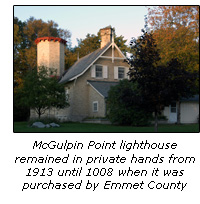 Over
the ensuing years, correspondence concerning the station included a
possible transfer to Mackinac State Historic Parks and use of the
station dock and dwelling during the construction of White Shoal
lighthouse, but neither of these options reached fruition. The
lighthouse finally passed into private ownership on July 30, 1913 when
a Sam Smith, an early Mackinaw City president and entrepreneur,
purchased the property for $1,425. The station was subsequently resold
a couple of times, last being owned by the Peppler family, from whom
the station was purchased by Emmet County in 2008. Over
the ensuing years, correspondence concerning the station included a
possible transfer to Mackinac State Historic Parks and use of the
station dock and dwelling during the construction of White Shoal
lighthouse, but neither of these options reached fruition. The
lighthouse finally passed into private ownership on July 30, 1913 when
a Sam Smith, an early Mackinaw City president and entrepreneur,
purchased the property for $1,425. The station was subsequently resold
a couple of times, last being owned by the Peppler family, from whom
the station was purchased by Emmet County in 2008.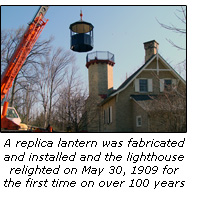 Soon
after purchasing the lighthouse, the County formed a Historical
Commission to plan and oversee the restoration and interpretation of
the lighthouse, with GLLKA's Straits Coordinator Sandy
Planisek serving
as Chair of this Commission, and GLLKA President Dick Moehl
serving as one of the Commissioners.. Emmet County’s mission is to
reestablish McGulpin Point Lighthouse as a private aid to
navigation
(PATON). The U.S. Coast Guard has approved the McGulpin Point
Lighthouse PATON application, and a contract was let late in 2008 to
Moran Iron Works, Inc. of Onaway, MI to construct a replica decagonal
lantern. Soon
after purchasing the lighthouse, the County formed a Historical
Commission to plan and oversee the restoration and interpretation of
the lighthouse, with GLLKA's Straits Coordinator Sandy
Planisek serving
as Chair of this Commission, and GLLKA President Dick Moehl
serving as one of the Commissioners.. Emmet County’s mission is to
reestablish McGulpin Point Lighthouse as a private aid to
navigation
(PATON). The U.S. Coast Guard has approved the McGulpin Point
Lighthouse PATON application, and a contract was let late in 2008 to
Moran Iron Works, Inc. of Onaway, MI to construct a replica decagonal
lantern. At a major major maritime event on May 30, 2009 the McGulpin Point lighthouse was reopened and relighted as an official Private Aid to Navigation on May 30, 2009, 103 years after it was extinguished. Emmet
Cunty is taking the entire light station trhrough a complete
restoration and opens the lighthouse seven days a week. Hours
are noon
to 5:00 PM
in May and October and from 10:00 AM to 8 PM from June through
September. To visit McGulpin Point, take Central Avenue west underneath I-75 and continue west approximately 2 miles until the road ends at a "T" intersection. Turn right at the "T" and the lighthouse is on the right side of the street just before the road descends down to lake level. There is parking on both sides of the street. Call 231-436-5860 of email info@emmetcounty.org for information. GPS
Coordinates: 45°47'13.64"N x 84°46'22.86"W |